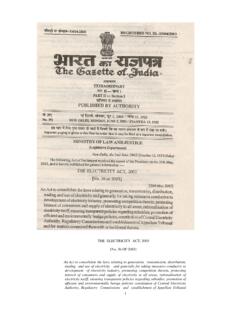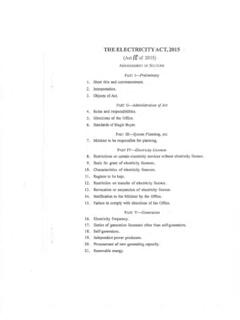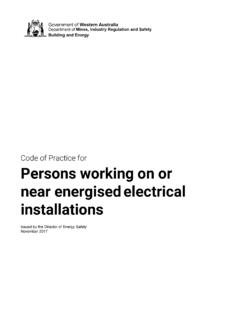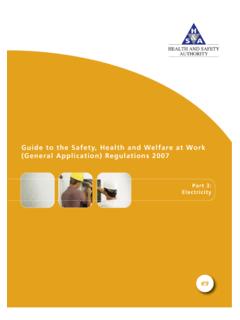Transcription of Electricity Easements - Energy NSW
1 ISSC 20 Guideline for the Management of Activities within Electricity Easements and Close to Electricity Infrastructure Industry Safety Steering Committee September 2012 ISSC 20 Guideline for the Management of Activities within Electricity Easements and Close to Electricity Infrastructure NSW Industry Steering Committee, September 2012 Page 2 of 32 First published by the Electricity Council of New South Wales February 1992 Revised by the Electricity Association of New South Wales November 2001 Re Issued with minor amendments by Department of Water and Energy June 2009 Revised by an Industry Safety Steering Committee of New South Wales appointed Working Group comprised of representatives from TransGrid, RailCorp, Endeavour Energy , Ausgrid, Essential Energy and the Trade and Investment Division of Resources and Energy in 2012 THE INDUSTRY SAFETY STEERING COMMITTEE OF NEW SOUTH WALES SERIES OF GUIDES In New South Wales, safety requirements for Electricity transmission, distribution and utilisation are contained in the Network Management Plans prepared by Electricity Network Operators.
2 These regulations specify the safety outcomes to be achieved whilst the means of achieving such outcomes are matters to be determined by the Electricity industry. The NSW Electricity supply industry has responded to these regulatory reforms by publishing an extensive series of guideline documents. These set out the industry s view of minimum practices which would enable an organisation, or individual, to fulfil the regulatory requirements. Whilst compliance with the regulation is mandatory, organisations or individuals may choose to depart from the recommendations of the guides provided that the necessary duty of care is exercised and the regulatory requirements are fulfilled. Under the Electricity Supply (Safety and Network management) Regulation 2008, the Director General of NSW Trade & Investment may nominate any industry code or guide to be taken into account in developing Network Management Plans.
3 The Industry Safety Steering Committee of New South Wales has recommended that the Director General nominate [this guide] to be taken into account in the development of such Plans. DISCLAIMER While due care has been exercised in the compilation of this Guide, much of the content has been sourced externally to the Industry Safety Steering Committee of New South Wales. Thus the Committee cannot accept responsibility for the content. This Guide is designed on the basis that it will be used in its entirety, and persons who use or observe parts of the publication without paying heed to the entirety of the publication do so at their own risk. This Guide has been prepared on the basis that the user will have a certain minimum level of technical qualifications and/or experience. The Guide is not intended for use by untrained or unqualified persons , and any one in that category using the guide does so at his/her own risk.
4 This Guide does not purport to ensure compliance with all relevant statutes and regulations, such as work place health and safety laws. Users must satisfy themselves as to the requirements of all relevant laws. CONTENTS Page SERIES OF 3 3 SCOPE .. 5 DEFINITIONS .. 6 REFERENCED 1. POWERS TO CONTROL ACTIVITIES WITHIN AN Electricity EASEMENT OR CLOSE TO Electricity INFRASTRUCTURE .. 8 Electricity Supply Act 1995, and associated Regulations .. 8 State Environmental Planning Policy (Infrastructure) 2007 .. 9 Land Acquisition (Just Terms Compensation) Act 1991 .. 10 WorkCover Authority of NSW Publications.
5 10 2. REGISTERED Easements .. 11 Acquiring 11 Powers to control activities on an 11 3. ELECTRICAL INFRASTRUCTURE WITHOUT REGISTERED Easements .. 12 Electrical Infrastructure on Public Roads and Electrical Infrastructure on other Electrical Infrastructure supplying a single 4. TYPICAL ACTIVITIES IMPACTING ON Electricity Easements AND INFRASTRUCTURE .. 13 Basis of assessment of risks associated with particular 5. APPROVAL FOR ACTIVITIES .. 17 6. SPECIFIC RESTRICTIONS WITHIN EASEMENT AREAS .. 17 7. OVERHEAD POWER 18 Permitted 18 Controlled 19 Prohibited Activities .. 24 8. UNDERGROUND CABLE Easements .. 25 Permitted Controlled 25 Prohibited Activities .. 27 9. PADMOUNT/KIOSK DISTRIBUTION SUBSTATIONS.
6 27 Permitted 27 Controlled 28 Prohibited Activities .. 28 10. APPLICATION 29 For Existing Encroachments onto Easements or close to Electricity infrastructure .. 29 For Proposed Encroachments .. 30 Flow Chart of 11. MINOR MEASUREMENT 12. PREFERRED EASEMENT 32 ISSC 20 Guideline for the Management of Activities within Electricity Easements and Close to Electricity Infrastructure SCOPE The reissue of this document was commissioned and endorsed by the Industry Safety Steering Committee of New South Wales. The purpose of this guide is to provide guidelines to assist Electricity Network Operators to: Ensure public safety. Protect the Electricity Network Operators assets from damage. Minimise the likely impact of structures or other impediments on Electricity Easements and infrastructure.
7 Maintain unimpeded access to Electricity Easements and infrastructure for the purposes of the Electricity Network Operators. Define the responsibilities of Developers, Property Owners and Occupiers, Consent Authorities and Proponents with respect to activities close to Electricity easement and infrastructure. Easements are primarily obtained or created in the Electricity industry to ensure the safety of persons living, working or playing near Electricity infrastructure. They are also created to ensure Electricity Network Operators can gain ready access to install, operate, maintain, repair, replace, upgrade and renew infrastructure. Similarly, Electricity infrastructure already constructed or installed without a formal easement is to be treated in the same manner as infrastructure that has a formal easement. Much of this infrastructure is protected by the Electricity Supply Amendment (Protection of Electricity Works) Act 2006.
8 This guide shall be read in conjunction with the provisions of the Electricity Supply Act 1995, the Electricity Supply (Safety and Network Management) Regulation 2008, the Electricity Supply (General) Regulation 2001, the NSW Government Code of Practice for Electricity Transmission and Distribution Asset Management and the NSW Government Code of Practice Distribution Risk Management, as well as any specific terms of the easement covenants. The guidelines have been established after careful consideration of access and safety aspects associated with the operation and maintenance, repair, replacement, upgrade or renewal of Electricity infrastructure on property, whilst being mindful of the property owner s rights to maximise use and enjoyment of the land. Due to the varied circumstances that apply to Electricity Easements and infrastructure, there may be special circumstances that will require individual assessment.
9 The particular circumstances, therefore, may call for restrictions over and above those outlined in this document. For guidance on vegetation management, refer to ISSC3 Guideline for Managing Vegetation near Power Lines. NSW Industry Steering Committee, September 2012 Page 5 of 32 ISSC 20 Guideline for the Management of Activities within Electricity Easements and Close to Electricity Infrastructure DEFINITIONS For the purpose of interpretation, the following definitions apply: Consent Authority Any body that has responsibility for approving an application for development in accordance with the provisions of the Environmental Planning and Assessment Act Developer Any person or organisation proposing to develop a parcel of land in accordance with the provisions of the Environmental Planning and Assessment Act Easement Area A term used in this document to refer to a formal Electricity Easement as defined in Section 2 or an area as defined in Section 3 where no formal easement exists, but the Electricity Network Operator has some control over the activities close to electrical infrastructure Electricity Easement Is an encumbrance on the title of land limited in width above or below the land conferring a right to construct, operate, maintain, repair, renew, replace or upgrade electrical infrastructure.
10 Electricity Infrastructure Any Electricity power lines, underground cables, substations or associated equipment or Electricity structures that form part of a transmission or distribution system. Electricity Network Operator Abbreviated to NO. Ausgrid, Endeavour Energy , Essential Energy , TransGrid, RailCorp and their successors. Induced Voltage/Current The voltage or current on a metallic structure resulting from the electromagnetic or electrostatic effect of a nearby powerline or underground cable. Step and Touch Voltages Step Voltage is the voltage between two points on the earth s surface that are 1m distant from each other while a person is making contact with these points. Touch Voltage is the voltage between conductive parts when touched simultaneously. Transferred Voltage Voltage rise of an earthing system caused by a current to earth transferred by means of a connected conductor (for example, a metallic cable sheath, pipeline, rail) into areas with low or no voltage rise relative to reference earth resulting in a voltage difference occurring between the conductor and its surroundings.









![Electricity Regulation Act [No. 4 of 2006]](/cache/preview/6/a/5/5/a/0/d/5/thumb-6a55a0d556b9c34cf91d66ae31989ed3.jpg)

